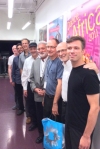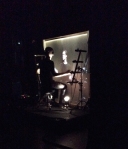As a member of the Steve Reich and Musicians ensemble since 1979, I’ve participated in several premiere performances at the Brooklyn Academy of Music (BAM) through the years. Last week I had the honor of being part of a three-day series of concerts showcasing both Steve Reich’s and Philip Glass’s music at this prestigious concert hall. Each night’s concert was split between their two groups and the concerts were sold out almost immediately, which gave 6,000 people three spectacular performances of major contemporary works. This series was in part a celebration of the 50th Anniversary of Nonesuch Records which has featured these two composers in many of its productions. Bob Hurwitz, President of Nonesuch Records just joined Nonesuch Records in the early 80’s, as we were premiering Steve’s Desert Music at BAM with Michael Tilson Thomas and the Brooklyn Philharmonic. We recorded this work the day after the performance.
In the mid-1960s a few composers were experimenting with new forms of composition. Among them were Steve Reich and Philip Glass. Their influences were quite varied and included African and Indian music, jazz, classical music and the gamelan music of Bali as well as the music of Terry Riley, La Monte Young and Moondog. At the time this music was considered experimental and the venues often were lofts in Manhattan or private gatherings.
In the mid-1970s, Harvey Lichtenstein, executive director of BAM, programmed many of these artists, giving them a large-scale venue to present their works. This led to the Next Wave Festivals which began in the early 1980s.
While Philip Glass and Steve Reich are often lumped together under the category of “minimalism”, this series of three concerts clearly illustrated the huge differences of their output. I performed in compositions of Steve’s in each of the three concerts. The first night included Music for 18 Musicians which won the group a Grammy for its 1998 recording. The second night we played Steve’s 1971 composition, Drumming. The last night, I played in his 1985 work, Sextet for two piano players and four percussionists.
Other Reich works performed included Four Organs, Clapping Music, Video Phase and WTC 911. The Philip Glass Ensemble played many of Glass’ compositions, including several excerpts from his famous Einstein on the Beach opera. Between the two groups there were over 30 performers and everyone came out at the very end for a full company bow to a standing ovation.
Minimalism has achieved very high acceptance and groups throughout the world now play this style of music. There is even a joke about minimalism which proves its acceptance in society: Knock knock, who’s there? Knock knock, who’s there? Knock knock, who’s there? Knock knock, who’s there? Philip Glass.
Here is the NY Times review of this series
http://www.nytimes.com/2014/09/15/arts/music/after-decades-steve-reich-and-philip-glass-reunite-at-bam.html?_r=0

One of the early members of Steve Reich & Musicians, Russell Hartenberger,
performed Clapping Music with Steve Reich

Percussionists from both groups from left to right are: Bob Becker, Yousef Sheronick, Frank Cassara, Steve Reich, Garry Kvistad, Thad Wheeler, Russell Hartenberger, and David Cossin (not pictured Gary Shall)

A last minute addition to the program, David Cossin performs his adaptation of the duo Piano Phase using drum pads while playing along with his video of the other player






